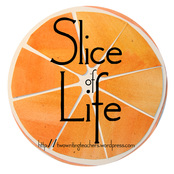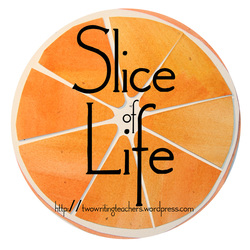The three books follow the same format but differ in the writing genre being presented. In the beginning of each book we see Stella in her classroom at the start of a new writing unit, engaging in the kind of prewriting strategy we would expect for that particular type of writing – listening to a classmate’s story about his new puppy, wondering and questioning about chameleons, or thinking about a topic that she really cares about. Stella takes us through every phase of the writing process from brainstorming to planning to drafting to revising. As readers, we have a front row seat to watch her writing piece unfold. Each book ends with an event that occurs two weeks after the conclusion of the writing, showing readers the powerful effects of writing when it is shared with others and reminding us that writing doesn’t always end with the last word on the page.
I was immediately drawn to Stella. She’s engaging, positive, and persevering – just the kind of writing mentor students need. As Wagstaff explains in her author’s note, “Stella’s a powerful mentor and will be a true inspiration for your students.” Stella’s teacher, Mrs. Merkley, is also a wonderful mentor. She knows just the right questions to ask to help her students expand on their thoughts, sometimes just nudging them with a “Tell me more…” response. She encourages talk in the classroom so all students have the opportunity to share and formulate ideas. And, when Stella gets stuck, Mrs. Merkley gently leads her to what she might consider on her own instead of simply telling her what to do.
The resources available for the books are an added bonus. In the back of each book, Wagstaff recounts the strategies mentioned in the story. For example, in Stella Tells Her Story, she reminds us of the specific pages where Stella used rereading and questioning to come up with a better ending. Not only will teachers find this resource useful while conducting conferences, but students themselves can find the specific pages in the book that address an area where they might need some help.
In addition, Wagstaff provides online resources at www.sde.com/Stella. Here teachers can find suggestions for using the books in their classrooms, error-free copies of Stella’s texts, and additional ideas and information about teaching writing. I was excited to read that Wagstaff not only encourages teachers to model with their own writing, but also places an emphasis on the value of shared writing at all levels. This is a step that is often left out because of time, but it is so essential for all students.
Remember to include modeled and shared writing regularly with older students.
They need the inside peek into a writer’s head and to cooperatively grapple with
composing text just as much as their younger cohorts.
http://www.sde.com/PD-Resources/Book-Resources/Stella/Default/Use-a-Combination-of-Writing-Modes
I am always looking for good mentor texts to pass along to teachers, and this series will definitely be one that I recommend. Both students and teachers will find inspiration from Stella!







 RSS Feed
RSS Feed
